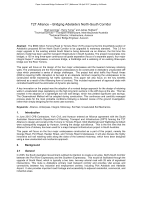Bridges

- Publication no: ABC2017-025-17
- Published: 20 April 2017
- PDF (free) Download
The $896 million Torrens Road to Torrens River (T2T) project is the first brownfields section of Adelaide’s proposed 88 km North South Corridor to be upgraded to motorway standard. This 3.5 km major upgrade to the existing arterial South Road is being delivered via an Alliance, the first time this delivery model has been used for transport infrastructure in South Australia. The project incorporates nine bridges, a 100 m long three-span continuous rail grade separation (focus of a separate paper), four major integral Super-T underpasses, a services bridge, a footbridge and a widening of an existing three-span bridge over the River Torrens.
This paper will focus on the design of the four major underpasses and the lowered motorway retaining walls. The underpasses are the first integral underpasses to be constructed in Adelaide’s unsaturated stiff clays which presented a series of design challenges. The project had strict traffic Key Result Areas (KRA’s) requiring traffic disruption to be kept to an absolute minimum requiring the underpasses to be constructed whilst maintaining full traffic operations. This paper will also focus on the key benefits delivered as a result of the Alliancing form of contract. This included replacement of approach slabs with controlled backfill and the elimination of dynamic pile testing.
A key innovation on the project was the adoption of a revised design approach for the design of retaining walls in unsaturated clays capitalising on the high long term suctions in the stiff clays at the site. This has resulted in the adoption of a lightweight soil nail wall design, which has yielded significant cost savings. The Observational Method will be adopted during construction. This continuous and carefully managed process plans for the most probable conditions following a detailed review of the ground investigation, rather than simply designing for the worst case scenario
